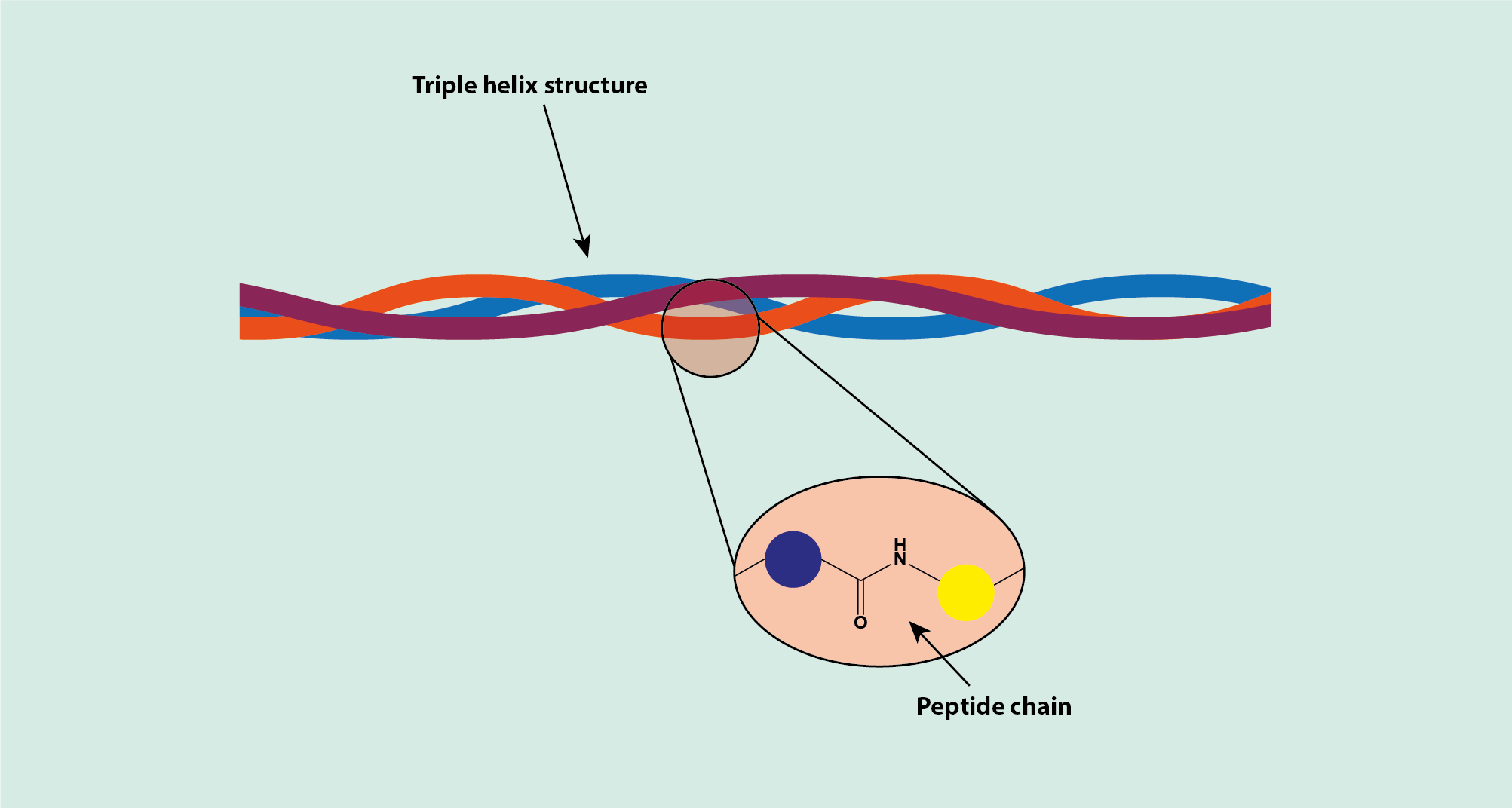Collagen
Collagen is the umbrella term for a range of common, naturally occurring proteins that give structure and strength to tissues, mainly as the prime component of connective tissues in all vertebrates. Collagen-type proteins are the most common proteins in mammals, accounting for approximately a third of the body’s proteins. There are dozens of varieties of collagen fibres, with different degrees of tensile strength, rigidity and compliance. A range of properties is necessary so that collagen fibres with optimised behaviours can be matched to different types of tissues and functions.

Figure 1 depicts the overall triple-helix structure of collagen fibres. Each strand is made up by peptide chains. Slightly different compositions in terms of amino acids in the peptide chain account for slightly different mechanical properties of the resulting collagen fibres, with fairly rigid collagen in bone, slightly less rigid varieties in cartilage or tendon, and compliant varieties in skin. Collagen fibres are also found in dentine in teeth, in blood vessels, in the digestive system, in the eyes (cornea) and in muscle tissue.
This versatile biopolymer has a number of biomedical applications. Collagens are biodegradable and highly biocompatible, have only weak antigenicity, are non-toxic and are compatible with other synthetic polymers, easily available in abundance, straightforward to modify and typically have more favourable properties than other biopolymers such as albumin or gelatin (denatured collagen). Unfortunately, highly purified type I collagen is fairly expensive and has variable properties (as all natural products do) and carries some small infection risks (for example, bovine spongiform encephalopathy when obtained from cattle). This is the reason why increasingly collagen products are being manufactured from marine creatures.
Collagen products can be manufactured as films, sheets, discs or sponges, as well as injectable suspensions.
Collagen products are probably best known for their non-medical uses, including cosmetic applications and food supplements. Cosmetic applications include subcutaneous injections of soluble collagen fractions as dermal (skin) or lip fillers. The plumping-up effects of such injections lasts for several months. The surface-active properties of collagen preparations are exploited in products aiming to protect hair and skin against the effects of detergents. Claimed benefits of collagen preparations as food supplements are unproven. A moment of critical thinking would probably be enough to convince oneself that it is not worth spending large amounts of money on such supplements: the amino acids in collagen products are not in any way different from those in a range of decent foods as part of a balanced diet. It should also be kept in mind that such products are not considered medicinal, so are not subject to the same rigid tests and assessments as medical products.
The most important medical applications of collagen products are as:
- drug delivery systems;
- as tissue scaffolds in reconstructive surgery;
- as wound dressings in a range of situations, especially in the treatment of severe burns.
Collagen sponges have a long history of nearly 100 years as wound dressings. Their unique properties help to absorb large quantities of exudate, wounds are kept moist, and are protected against mechanical harm as well as (to some extent) bacterial infections. Collagen sheets can also be manufactured such that they provide elastic sealants for surgical wounds. In a wider sense, collagen products have a role beyond traditional wound dressing by providing ‘artificial skin’ (sometimes also referred to as soft tissue engineering, encouraging skin regeneration after burns or other extended skin damage by acting as scaffold, adhesive and sealant simultaneously. Similar applications exist in ophthalmology in treating the cornea (outer layer of the eye).
Collagen fibres are found almost everywhere in the body, thus many different reconstructive surgical specialties take advantage of these materials. Haemostatic properties (stopping bleeding) are generally advantageous. More specifically, collagen preparations play a role in general wound repair (and dressing), nerve repair, as prostheses and vascular grafts for damaged blood vessels, a range of orthopaedic surgical reconstructions of tendon, cartilage, ligaments and bone, in urology (haemodialysis).
The versatility of collagen preparations is particularly useful to exploit these materials as drug delivery vehicles in many different ways. For example, collagen materials can deliver slow-release of drugs in a highly controlled way. Collagen sponges are particularly useful to deliver locally high concentrations of antibacterial agents, with very low serum concentrations of the drug. Collagen sponges containing gentamicin are widely used for such purposes in orthopaedic surgery, but also in maxillofacial surgery. More specialised preparations can be used to deliver genetically modified cells to target regions, or to provide controlled morphogenetic proteins locally for hard tissue regeneration.